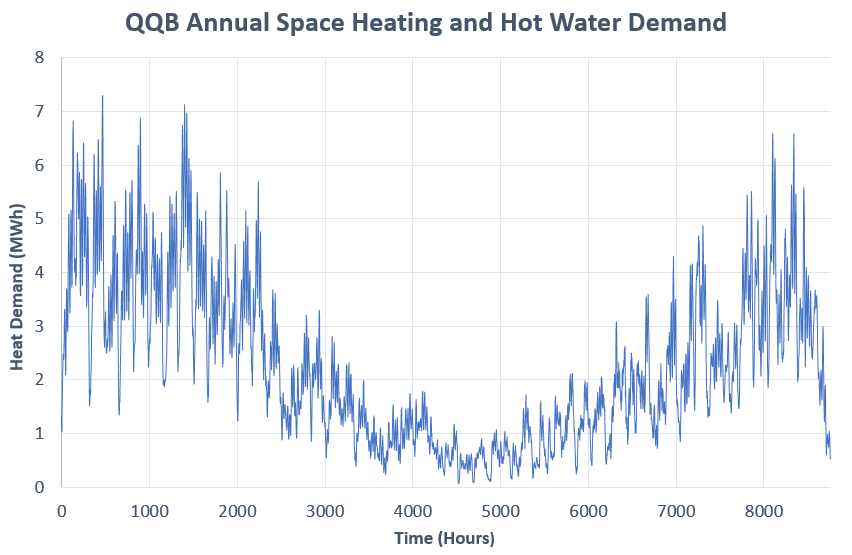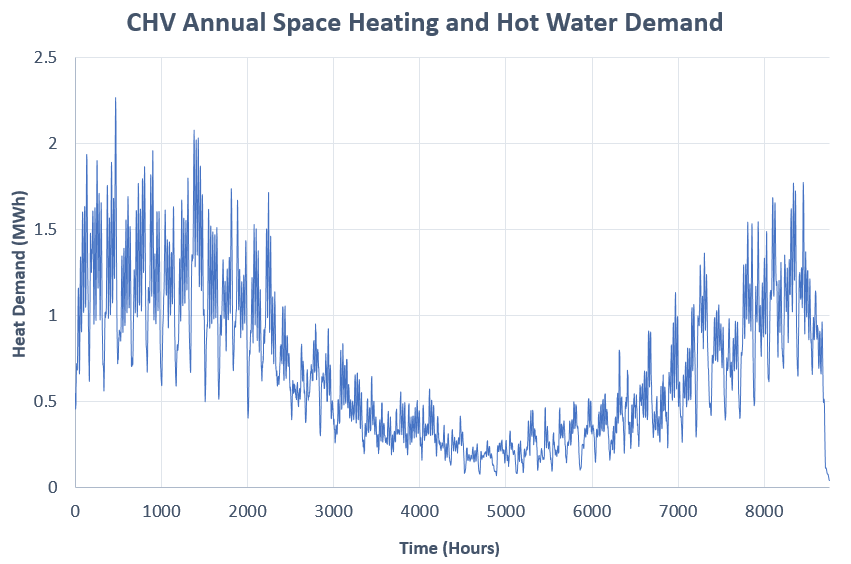Heat Demand Estimation
At early planning stages of a district scale development, when the topology of the district and the final characteristics of individual buildings have not yet been specified, heat demand can be estimated using simplified methods. [1] Detailed dynamic modelling of the buildings is out of the scope of this project, as it would have been too time consuming due to the size of the development under study and the large number of uncertainties. Previous research projects and feasibility studies on the implementation of renewables in community and district scale systems have made use of GIS maps, in order to measure floor areas of specific buildings, and national energy benchmarks for energy use (in kWh/m2), in order to estimate the annual energy consumption of those buildings for space heating and hot water.[2]
In this project, using the currently available site masterplan, the number of homes was taken to be 700 and the demand was estimated for 9 non residential buildings, which included a leisure centre, college, library and shopping centre. The residential buildings consisted of flats, semi-detached, detached and terraced houses. Indicative floor areas were calculated for all buildings.
To estimate the daily heat consumption the Degree Days (DD) method was used. This is a method used to analyse energy consumption in buildings, and is basically the sum of the differences between the outdoor temperature and a base temperature over a defined period of time. Applying the DD method can help estimate the energy demand and, consequently, carbon emissions from space heating and cooling for new buildings or major refurbishments. However, one of the main problems with this method is the definition of the base temperature, which refers to the energy balance between the building and the heating system, and makes rough assumptions about the values of the annual internal heat gains.[3]
For the space heating demand calculations, 2018 heating degree days for the Glasgow airport area were used. The base temperature used for the UK is 15.5°C, meaning that buildings will not need supplementary heating at this temperature.[4] This was advantageous because not only is this recent data, but it represents the worst case scenario a heating system will have to encounter due to the extreme weather conditions in Scotland that year. As for the energy demand for hot water, reasonable assumptions were made according to the use of each building, following the suggested hot water use values by the UK Chartered Institution of Building Services Engineers (CIBSE).[1]
Since the focus of this project is on the successful integration of renewable energy resources, whose availability varies significantly with time, in a district energy system, daily demand estimation was not sufficient. Time-resolved energy demand data (hourly, in this case) needed to be generated, in accordance with the total annual and daily demand.[5]

- For the residential buildings, the Carbon Trust Biomass Decision Support Tool was used first to determine the peak loads of each type of home on a specific design day. The peak load of each building was then divided by the temperature difference between the internal and external temperatures of the building to get the overall heat loss coefficient (kW/K) which was then inputted into the following equation to calculate the heating energy demand, using the DD Method:[3]
Heat demand (kWh) = Overall heat loss coefficient (kW/k)*DDays(K.day)*24(h/day)
- For the non residential buildings, a similar approach was used to generate daily heat demand profiles. However, the overall heat loss coefficient of each building was calculated according to the BS EN 12381-1 standard [6], having assumed reasonable U-values for the elements of each building (taking in consideration whether it was existing or new build). Post-2013 U-values were used for the new non residential buildings planned for the Queens Quay development.[1]
As explained above, hourly demand profiles for all the buildings were also required. Therefore, actual metered data for Scottish buildings of various uses were used to generate hourly time series for all the buildings in the development.[7] In the end, the annual consumptions of the non residential buildings were less than or equal to those provided by CIBSE TM46 energy benchmarks.[8]
Heat Demand Reduction
A substantial amount of Scotland’s energy consumption and CO2 emissions comes from heating and cooling buildings. The aim is to reduce, and eventually, eliminate the greenhouse gas emissions associated with the generation and use of heat, essentially decarbonising heating systems. The efficiency of a building’s heating system, the building fabric design and the controls system are of great importance to achieve optimal thermal comfort for occupants and increase the overall energy efficiency of the building.[9]
One of the aims of the Energy Efficient Scotland programme is to reduce residential demand by 15% and non-residential demand by 20% by 2032. This will be achieved by designing new buildings and refurbishing older ones in order to minimise heat losses, mainly through choice of building fabric and insulating to a maximum appropriate level. In turn, this reduction of energy demand will reduce pressure on household energy bills, which will help tackle fuel poverty.[9]
In this study, the energy efficiency standard used to reduce demand to its lowest possible value is Passivhaus Standard. As well as being highly energy efficient, Passivhaus buildings are also affordable and provide optimal thermal comfort. These buildings only require up to 15kWh/m2 annually for heating and cooling because heat losses are reduced so much that it barely needs heating at all.[10] Furthermore, Passivehaus buildings can reduce space heating requirements by 75% compared to standard practice for UK new build, making it the best method to help reduce greenhouse gas emissions from heating and cooling buildings.[11]
The Passive House Planning Package (PHPP) is the most common software used to design Passivhaus buildings, however, this requires detailed information about the building fabrics, which is out of scope of this project. Therefore, to determine the hourly demand for the Passivehaus buildings, the advanced options in the Home Energy Model (HEM) software were used, which gave space heating and hot water demands less than or equal to Passivhaus standards. The baseline scenario hourly demand profiles were then scaled down for each type of dwelling to meet the Passivhaus requirements. Furthermore, the non residential buildings demand profiles were scaled down by 70%, based on recent research in refurbishing buildings in cold climates.[12]
Heat Demand Analysis Results
For the QQB scenario, the annual heating demand amounted to 19.8 GWh, whereas for the CHV scenario, it was only 6.09 GWh for the year 2018. Implementing energy efficiency methods to the buildings in the development produced an overall energy reduction of approximately 70%, which will result in a significant reduction in carbon dioxide emissions associated with space and water heating. Furthermore, following these methods has also allowed the development to be significantly 'decarbonised' even before integrating low carbon sources of heat. The following tools and guides were used to validate the heat demand results calculated for this study:
- Scotland Heat Map
- CIBSE TM46[8]
- Energy Performance of Homes using Modern Methods of Construction (Edinburgh Napier University)[13]

The heat demand of the low energy performance development (QQB scenario)

The heat demand of the high energy performance development (CHV scenario)